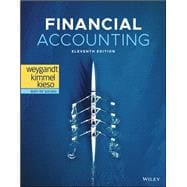To understand a business, you have to understand the financial insides of a business organization. Through a focus on accounting transactions, real-world problem-solving, and engaging industry examples, Weygandt Financial Accounting, 11th edition demonstrates how accounting is an exciting field of study and helps connect core financial accounting concepts to students' everyday lives and future careers.
Continuing to help students succeed in their introductory financial accounting course for over two decades, this edition brings together the trusted Weygandt, Kimmel, and Kieso reputation with fresh, timely, and accurate updates to help build confidence and engage today's students.









